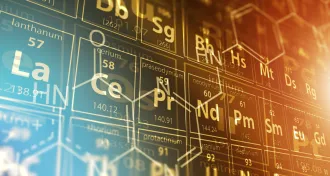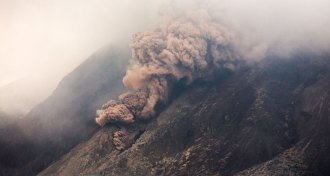Physics
Sign up for our newsletter
We summarize the week's scientific breakthroughs every Thursday.
-
 Chemistry
Chemistry50 years ago, scientists fought over element 104’s discovery
A conflict known as the Transfermium Wars marked a contentious struggle over the search for new elements beginning in the 1960s.
-
 Particle Physics
Particle PhysicsThis is the slowest radioactive decay ever spotted
Scientists have made the first direct observations of an exotic type of radioactive decay called two-neutrino double electron capture.
-
 Astronomy
AstronomySeeing very far away and hitting closer to home
Editor in Chief Nancy Shute discusses the first-ever image of a black hole and what can be done to help young children with anxiety.
By Nancy Shute -
 Physics
PhysicsThe M87 black hole image showed the best way to measure black hole masses
The first image of M87’s black hole suggests it is 6.5 billion times the mass of the sun — close to what was expected based on how stars move around it.
-
 Materials Science
Materials ScienceA new graphene foam stays squishy at the coldest temperatures
Researchers have now made a material that is superelastic even at extremely cold temperatures, which could be helpful in space.
-
 Astronomy
AstronomyMeet one of the first scientists to see the historic black hole image
Kazunori Akiyama was one of the first scientists to see the black hole snapshot.
-
 Astronomy
AstronomyHow scientists took the first picture of a black hole
Here’s how scientists connected eight observatories across the world to create one Earth-sized telescope in order to create an image of a black hole.
-
 Astronomy
AstronomyAll you need to know about the history of black holes
From dreaming up black holes to snapping the first picture of one, the history of black holes has had many twists.
-
 Astronomy
AstronomyThe first picture of a black hole opens a new era of astrophysics
Astronomers used a network of telescopes around the world to take a picture of the supermassive black hole in the galaxy M87.
By Lisa Grossman and Emily Conover -
 Earth
EarthHow deadly, fast-moving flows of volcanic rock and gas cheat friction
Mixtures of hot volcanic rock and gas called pyroclastic flows travel so far by gliding on air, a new study suggests.
-
 Materials Science
Materials ScienceBacteria can be coaxed into making the toughest kind of spider silk
Lab-altered bacteria have made a copy of a spider’s strongest silk strands, which could one day be used to make more sturdy materials.
By Jeremy Rehm -
 Physics
PhysicsThe LIGO and Virgo gravitational wave detectors are back on
Souped-up instruments could spot never-before-seen sources of gravitational waves.